Konjaku Hyakki Shūi
Konjaku Hyakki Shūi (今昔百鬼拾遺, "Supplement to The Hundred Demons from the Present and the Past") is the third book of Japanese artist Toriyama Sekien's Gazu Hyakki Yagyō tetralogy, published ca. 1781. These books are supernatural bestiaries, collections of ghosts, spirits, spooks and monsters, many of which Toriyama based on literature, folklore, and other artwork. These works have had a profound influence on subsequent yōkai imagery in Japan. Konjaku Hyakki Shūi is preceded in the series by Gazu Hyakki Yagyō and Konjaku Gazu Zoku Hyakki, and succeeded by Gazu Hyakki Tsurezure Bukuro.
A version of the tetralogy translated and annotated in English was published in 2016, which included this work, whose title is rendered as More of the Demon Horde from Past and Present.[1]
List of creatures
The three volumes were titled Cloud (雲), Mist (霧), and Rain (雨).[2]
First Volume - Cloud

 Shokuin (ja:燭陰) is the spirit of China's Purple Mountain. It appears as a red, man-faced dragon, a thousand ri tall.[4]
Shokuin (ja:燭陰) is the spirit of China's Purple Mountain. It appears as a red, man-faced dragon, a thousand ri tall.[4]
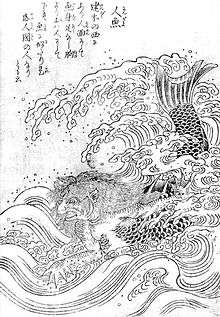

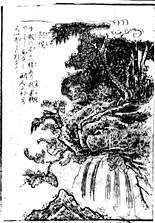 Hōkō (彭侯) is a spirit which lives inside a thousand-year-old tree. It resembles a black dog with a human face and no tail.[8]
Hōkō (彭侯) is a spirit which lives inside a thousand-year-old tree. It resembles a black dog with a human face and no tail.[8]
 Dōjōjinokane (道成寺鐘, the bell of Dōjōji temple) is the bell which was melted by Kiyohime, a woman who fell in love with a young priest, and through the rage of unrequited love became a terrible serpent demon. When the priest fled and hid underneath this temple bell, the serpent surrounded the bell and destroyed herself and her would-be lover in flames of her rage.[10]
Dōjōjinokane (道成寺鐘, the bell of Dōjōji temple) is the bell which was melted by Kiyohime, a woman who fell in love with a young priest, and through the rage of unrequited love became a terrible serpent demon. When the priest fled and hid underneath this temple bell, the serpent surrounded the bell and destroyed herself and her would-be lover in flames of her rage.[10]
 Dorotabō (ja:泥田坊, muddy rice field fellow) is the ghost of an old man who worked hard to pass on his rice fields to his descendants. His children squandered the fields and sold them to someone else, and so the old man appeared in the fields as a black, one-eyed creature crying for his rice fields to be returned.[12]
Dorotabō (ja:泥田坊, muddy rice field fellow) is the ghost of an old man who worked hard to pass on his rice fields to his descendants. His children squandered the fields and sold them to someone else, and so the old man appeared in the fields as a black, one-eyed creature crying for his rice fields to be returned.[12] Kokuribaba (ja:古庫裏婆, hag of the old priest's quarters) was a woman who came to a mountain temple and was called the head priest's wife, because she lived in his quarters. She stole rice and money from the people who came to the temple, and as punishment became a terrible demon hag who eats the skin from corpses.[13]
Kokuribaba (ja:古庫裏婆, hag of the old priest's quarters) was a woman who came to a mountain temple and was called the head priest's wife, because she lived in his quarters. She stole rice and money from the people who came to the temple, and as punishment became a terrible demon hag who eats the skin from corpses.[13] Oshiroibaba (ja:白粉婆, face-powder hag) is an old woman who is the assistant of Jibun Senjō, the spirit of face powder. She walks through the snow during the twelfth month of the lunar calendar, wearing an oversized sugegasa hat.[14]
Oshiroibaba (ja:白粉婆, face-powder hag) is an old woman who is the assistant of Jibun Senjō, the spirit of face powder. She walks through the snow during the twelfth month of the lunar calendar, wearing an oversized sugegasa hat.[14]

 Kerakeraonna (ja:倩兮女)
Kerakeraonna (ja:倩兮女)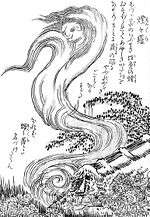
Second Volume - Mist
Third Volume - Rain
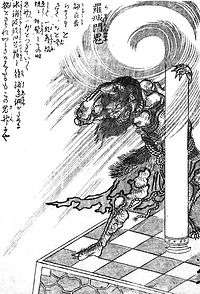
 Yonakinoishi (夜啼石)
Yonakinoishi (夜啼石)
 Suzuri-no-tamashii (ja:硯の魂)
Suzuri-no-tamashii (ja:硯の魂)
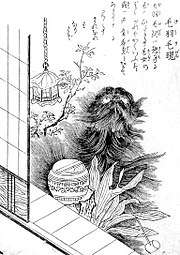 Keukegen A small dog-like creature covered entirely in long hair.
Keukegen A small dog-like creature covered entirely in long hair. Mokumokuren A swarm of eyes that appear on a paper sliding door in an old building.
Mokumokuren A swarm of eyes that appear on a paper sliding door in an old building. Kyōkotsu (ja:狂骨)
Kyōkotsu (ja:狂骨)
 Ushirogami (ja:後神)
Ushirogami (ja:後神) Iyaya (ja:否哉)
Iyaya (ja:否哉)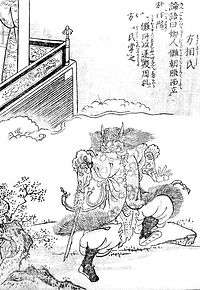
 Takirei-ō (ja:滝霊王)
Takirei-ō (ja:滝霊王) Hakutaku A beast which handed down knowledge on harmful spirits.
Hakutaku A beast which handed down knowledge on harmful spirits. Kakurezato (ja:隠里)
Kakurezato (ja:隠里)
Bashōnosei

Bashōnosei (ばしょうのせい, Japanese banana spirit) is a ghost in Toriyama Sekien's collection of monster paintings, "Konjaku Hyakki Shūi". The spirit of Basho transforms a person by taking the form of a person.
Overview
According to the commentary of "Hundred demon hunting", "The story that Basho's spirit can turn into a person is in Karato (China), and the song" Basho "was created by this." Of the "Koukai Shimbun Iken"[21] There is a mysterious story where Basho's spirit turns into a human figure, and Basho's spirit appears as a woman under a monk who is reading a book and asks, "Is it possible to make a heartless plant or Buddha?" "Bashio"[22] is based on the Chinese "Hukai Shimbun".[23]
References
- Yoda, Hiroko; Alt, Matt (2016). Japandemonium Illustrated: The Yokai Encyclopedias of Toriyama Sekien. Dover Publications. ISBN 978-0-486-80035-6.
- Toriyama Sekien 鳥山石燕 (1805). "Morin-ji [no] kama 茂林寺釜". Konjaku Hyakki Shūi 百鬼夜行拾遺 3巻(今昔百鬼拾遺). 1 (雲). Naganoya Kanbē.; 2 (kiri), 3 (ame).((in Japanese)
- http://park.org/Japan/CSK/hyakki/zukan/jyuui/kumo/sinkiro.html
- http://park.org/Japan/CSK/hyakki/zukan/jyuui/kumo/syokuin.html
- http://park.org/Japan/CSK/hyakki/zukan/jyuui/kumo/ninmen.html
- http://park.org/Japan/CSK/hyakki/zukan/jyuui/kumo/ningyo.html
- http://park.org/Japan/CSK/hyakki/zukan/jyuui/kumo/hangon.html
- http://park.org/Japan/CSK/hyakki/zukan/jyuui/kumo/houkou.html
- http://park.org/Japan/CSK/hyakki/zukan/jyuui/kumo/tengutu.html
- http://park.org/Japan/CSK/hyakki/zukan/jyuui/kumo/dojoji.html
- http://park.org/Japan/CSK/hyakki/zukan/jyuui/kumo/todaiki.html
- http://park.org/Japan/CSK/hyakki/zukan/jyuui/kumo/dorotabo.html
- http://park.org/Japan/CSK/hyakki/zukan/jyuui/kumo/kokuriba.html
- http://park.org/Japan/CSK/hyakki/zukan/jyuui/kumo/osiroi.html
- http://park.org/Japan/CSK/hyakki/zukan/jyuui/kumo/c_jakotuba.html
- http://park.org/Japan/CSK/hyakki/zukan/jyuui/kumo/kageonna.html
- http://park.org/Japan/CSK/hyakki/zukan/jyuui/kumo/enenra.html
- http://park.org/Japan/CSK/hyakki/zukan/jyuui/kiri/momijiga.html
- http://park.org/Japan/CSK/hyakki/zukan/jyuui/kiri/oborogu.html
- http://park.org/Japan/CSK/hyakki/zukan/jyuui/kiri/kazenbo.html
- (無名). (in Chinese) – via Wikisource.
- 大和田建樹 (1896). 謡曲通解. 5 (増補 ed.). 博文館. pp. 14–21. doi:10.11501/876558.
- 高田衛監修 稲田篤信・田中直日編 (1992). 鳥山石燕 画図百鬼夜行. 国書刊行会. pp. 236頁. ISBN 978-4-336-03386-4.
Further reading
- http://scene5.com/yokai/database/index/b3.htm
- http://park.org/Japan/CSK/hyakki/etc/obake_index-iroha.html
- Toriyama, Sekien (2005). Toriyama Sekien Gazu Hyakki Yagyō Zen Gashū. Kadokawa Sophia Bunko (in Japanese). Kadokawa Shoten. ISBN 978-4-04-405101-3.
- Natsuhiko Kyogoku and Katsumi Tada (ja:多田克己) (2000). Yōkai Zukan (in Japanese). Kokusho Kankokai (ja:国書刊行会). ISBN 978-4-336-04187-6.
- Kenji Murakami (ja:村上健司) (2000). Yōkai Jiten (in Japanese). Mainichi Shimbun. ISBN 978-4-620-31428-0.
External links



















